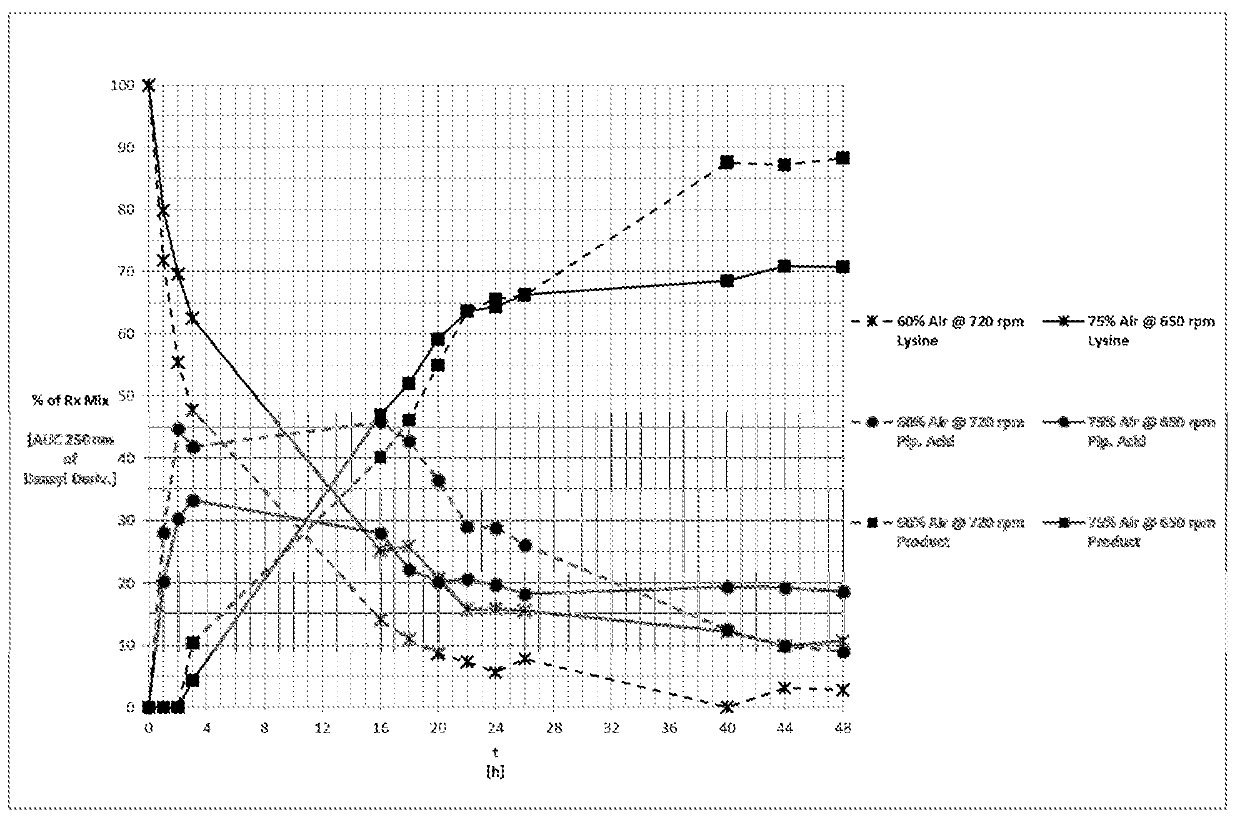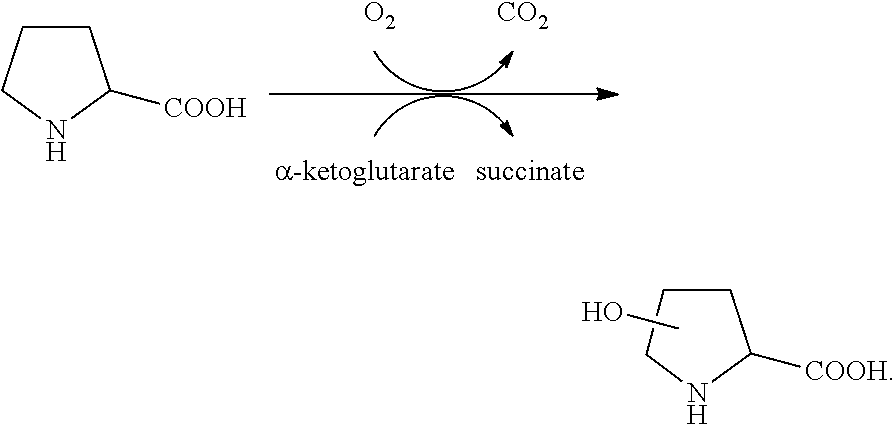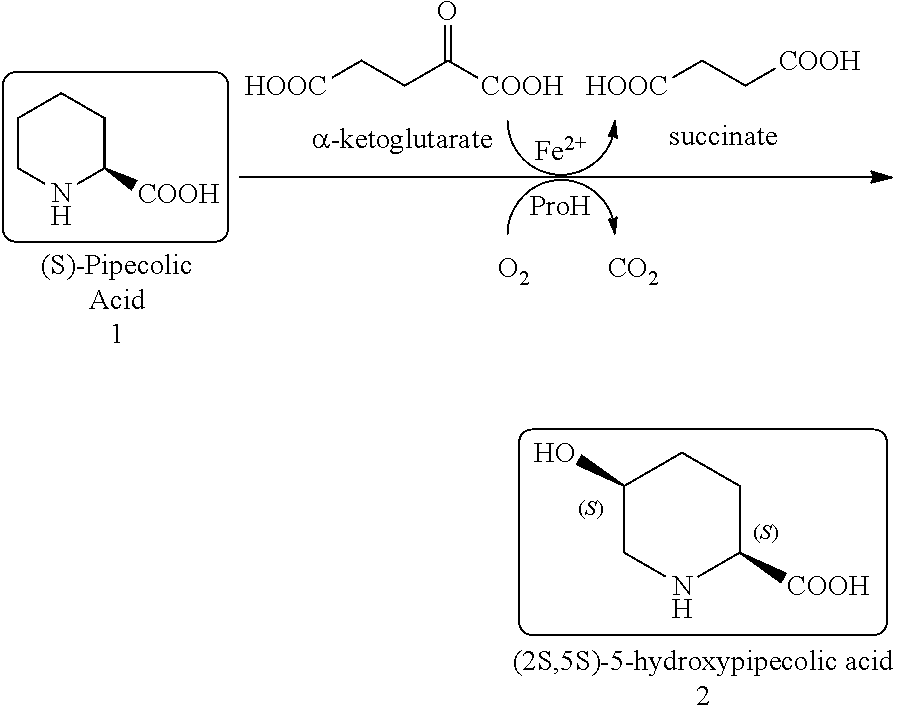Polynucleotides encoding biocatalysts and methods for hydroxylation of chemical compounds
a technology of polynucleotides and biocatalysts, applied in biochemistry apparatus and processes, oxidoreductases, enzymology, etc., can solve the problems of complex steps, lack of certain desired diastereomers, limited isolation from natural sources, etc., and achieve the effect of improving properties
- Summary
- Abstract
- Description
- Claims
- Application Information
AI Technical Summary
Benefits of technology
Problems solved by technology
Method used
Image
Examples
example 1
Expression and Screening Engineered Proline Hydroxylase Polypeptides
[0698]The polynucleotide sequence SEQ ID NO:4 (See, SEQ ID NO:134 of WO2013 / 169725A2) was cloned into a pCK110900 vector system (See e.g., US Pat. Appln. Publn. 2006 / 0195947, which is hereby incorporated by reference herein), pJV110900 vector system (SEQ ID NO:1007), pJV110900 a18c RBS vector system (SEQ ID NO:1008) or pJV110900 gc RBS vector system (SEQ ID NO:1009) and subsequently expressed in the E. coli W3110 strain. The E. coli W3110 strain expresses the proline hydroxylase polypeptides under the control of the lac promoter. Based on sequence comparisons with other proline hydroxylases and computer modeling of the enzyme structure docked to the substrate proline, residue positions associated with the active site, peptide loops, solution / substrate interface, and potential stability positions were identified and subjected to mutagenesis. These first round variants were screened under HTP Assay conditions with (2S...
example 2
Production of Engineered Proline Hydroxylases
[0699]As indicated above, the engineered proline hydroxylase polypeptides of Example 1 were produced in E. coli W3110 under the control of the lac promoter. Enzyme preparations for HTP, DSP, and SFP assays were made as follows.
High-Throughput (HTP) Growth, Expression, and Lysate Preparation
[0700]Cells were picked and grown overnight in LB media containing 1% glucose and 30 μg / mL chloramphenicol (CAM), 30° C., 200 rpm, 85% humidity. A 20 μL aliquot of overnight growth was transferred to a deep well plate containing 380 μL 2×TB growth media containing 30 μg / mL CAM, 1 mM IPTG, and incubated for ˜18 h at 30° C., 200 rpm, 85% humidity. Cell cultures were centrifuged at 4000 rpm, 4° C. for 10 min., and the media discarded. Cell pellets were resuspended in 200 μL lysis buffer (50 mM Bis-Tris buffer, pH 6.3, containing, 0.5 mg / mL PMBS, 1 mM MgSO4 and 1 mg / mL lysozyme). Lysis buffer was prepared fresh by adding to 90 mL of 50 mM Bis-Tris buffer, p...
example 3
Analytical Procedures
[0703]In this Example, the analytical procedures used to characterize the enzyme variants provided herein are described.
Method 1—HPLC Analysis of HTP Assay, SFP and DSP Reactions:
[0704]In a 96 deep well format assay block, 5 uL of reaction solution was diluted with 200 uL of 5% sodium bicarbonate solution followed by 200 uL of dansyl chloride solution (10 mg / mL dansyl chloride in MeCN). The plate was heat sealed, centrifuged, and placed in an incubator with shaking at 600 rpm at 44-45° C. for 1 hour. The reaction solution turns from yellow to light yellow when derivatization with dansyl chloride is complete. In cases where the solution remained yellow, the plate was heated for another 15 min. After incubation, the plate was centrifuged for 1 min at 4000 rpm. A 20 uL aliquot of supernatant was transferred into a 96 Corning plate containing 140 ul of water per well for HPLC analysis. The quenched reaction was subject to HPLC analysis under the following conditions...
PUM
 Login to View More
Login to View More Abstract
Description
Claims
Application Information
 Login to View More
Login to View More - R&D
- Intellectual Property
- Life Sciences
- Materials
- Tech Scout
- Unparalleled Data Quality
- Higher Quality Content
- 60% Fewer Hallucinations
Browse by: Latest US Patents, China's latest patents, Technical Efficacy Thesaurus, Application Domain, Technology Topic, Popular Technical Reports.
© 2025 PatSnap. All rights reserved.Legal|Privacy policy|Modern Slavery Act Transparency Statement|Sitemap|About US| Contact US: help@patsnap.com



